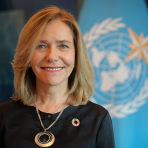Statement on the occasion of the high-level event on Delivering Early Warnings for All and Addressing Extreme Heat
Good afternoon and welcome to this high-level event on Delivering Early Warnings for All and Addressing Extreme Heat.
At the outset this COP, WMO’s State of the Climate 2024 Update showed that 2024 is on track to be the hottest year on record. Unfortunately we must brace ourselves for increasingly hazardous weather as a result of rising temperatures.
Early Warnings for All is no longer a lofty aspiration. It is an essential climate adaptation strategy.
We are proud of being part of EW4All. After around two years of collaborative efforts, we can report notable progress. 0ver 30 countries have embraced the Early Warnings for All initiative to define their own roadmaps. Thanks to enhanced awareness, over half of all countries—particularly in Africa, Latin America, and the Caribbean— are now establishing Multi-Hazard Early Warning Systems. According to this year’s report on the Global Status of Multi-Hazard Early Warning Systems, the world is at its highest levels of early warning coverage since 2015. And we will share some of the positive outcomes here today.
Early Warnings protect lifes
We have clear evidence that early warnings save lives if they lead to early action. One example: earlier this year the WMO regional climate centre in Africa earlier predicted above-average rainfall for much of the Greater Horn of Africa. National meteorological services downscaled this to national level. In Somalia alone, early warning messages reached nearly 1.9 million people, triggering anticipatory cash payouts for close to 80,000 individuals. This helped save lives and livelihoods among especially vulnerable communities. From regional to national level.
Collaboration is a MUST
Yet, only a third of countries have critical anticipatory plans and two thirds have enabling governance mechanisms in place. Even where multi-hazard early warning systems exist, there may be critical gaps along the value chain that must be addressed. For example, pillar 1 on risk knowledge continues to lag behind. Tied adding the latest technology and innovation, from phones, to machine learning and AI, we’ve found a great challenge at connecting all the relevant actors and building on the reality on the ground.
A Strong Foundation for successful EWS are Governance, Knowledge, and Data Sharing.
We must accelerate and expand our efforts to keep pace with the climate crisis. WMO and its 193 Members have made Early Warnings For All a top priority. We have mobilized collaboration at the global, regional and national levels.
We have 53 active projects in 103 countries and are expanding to 30 more countries through 14 more projects.
National Meteorological and Hydrological Services (NMHS) work tirelessly to deliver critical observations, forecasts, and warnings. We are honored to have you here with us today.
We are here today to talk about extreme heat – the silent killer. We also have a role to play here, and we are happy to share them with you today.
WMO was an active partner in the UN Secretary-General's Call to Action on Extreme Heat and we are scaling up activities in response. The WMO-WHO Joint Office for Climate & Health spearheads the Global Heat Health Information Network as a key mechanism for partnership, knowledge and user engagement.
Forecasts and warnings from national meteorological services are the linchpin of heat-action plans. We must ensure that they reach the last mile as part of Multi-Hazard Early Warning Systems.
One thing is clear: to meet our shared goals, we must expand our coalition and strengthen partnerships.
The climate crisis demands a collective, "whole-of-society" approach, reaching across sectors and disciplines.
Broadening the tent is not just about involving more actors; it’s about empowering everyone to champion Early Warning Systems as a core priority.
I look forward to hearing from those around the table on how you have taken up this mandate and action.
Statement by


